A fighting game is a genre of video game that involves combat between two or more characters. Fighting game combat often features mechanics such as blocking, grappling, counter-attacking, and chaining attacks together into "combos". Characters generally engage in battle using hand-to-hand combat—often some form of martial arts. The fighting game genre is related to, but distinct from, the beat 'em up genre, which pits large numbers of computer-controlled enemies against one or more player characters.

Virtua Fighter is a fighting game created for the Sega Model 1 arcade platform by AM2, a development group within Sega, headed by Yu Suzuki. An early prototype version was location tested in Japan by August 1993, before the complete game was released worldwide in December 1993. It is the first game in the Virtua Fighter series, and the first arcade fighting game to feature fully 3D polygon graphics. The game has been ported to several platforms including the Sega Saturn, Sega 32X, and Microsoft Windows.

Virtua Cop is a 1994 light gun shooter game developed by Sega AM2 and designed by Yu Suzuki. It was originally an arcade game on the Sega Model 2 system, and was ported to the Sega Saturn in 1995 and Windows in 1996. The Saturn version included support for both the Virtua Gun and Saturn mouse, as well as a new "Training Mode" which consists of a randomly generated shooting gallery.
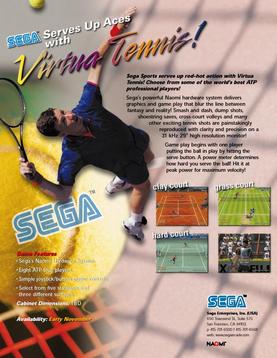
Virtua Tennis, known in Japan as Power Smash, is a 1999 tennis arcade game created by Sega. The player competes through tennis tournaments in an arcade mode. It was ported to the Dreamcast in 2000, and to Windows in 2002. A Game Boy Advance version was also released in 2002, followed by an N-Gage version in 2003. For the home console market, the game was expanded with the introduction of the campaign mode.

Sonic Advance, known as SonicN on the N-Gage, is a 2001 platform game developed by Dimps and published by Sega for the Game Boy Advance. It was the first Sonic the Hedgehog game released on a Nintendo console with Sonic Adventure 2: Battle on the GameCube, and was produced in commemoration of the series' tenth anniversary. The story follows Sonic, Tails, Knuckles, and Amy as they journey to stop Doctor Eggman from taking over the world. Controlling a character, players are tasked with completing each level, defeating Eggman and his robot army, and collecting the seven Chaos Emeralds.
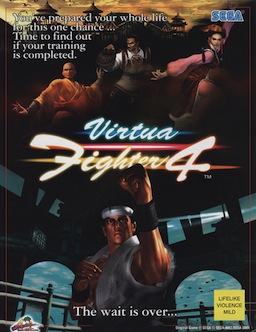
Virtua Fighter 4 is a fighting game by Sega. It is the fourth game in the Virtua Fighter series.
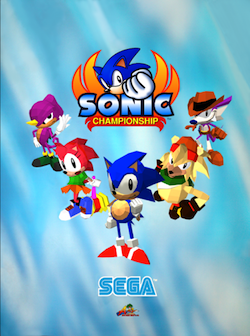
Sonic the Fighters, also known as Sonic Championship on arcade versions outside Japan, is a fighting game developed by Sega AM2. First released in 1996 in arcades on Sega's Model 2 arcade system, Sonic the Fighters pits players in one-on-one battles with a roster of characters from the Sonic the Hedgehog series.

F-Zero GX is a 2003 racing video game developed by Amusement Vision and published by Nintendo for the GameCube console. It runs on an enhanced version of the engine used in Super Monkey Ball. F-Zero AX, the arcade counterpart of GX, uses the Triforce arcade system board conceived from a business alliance between Nintendo, Namco and Sega. Published by Sega, it was released alongside GX in 2003.
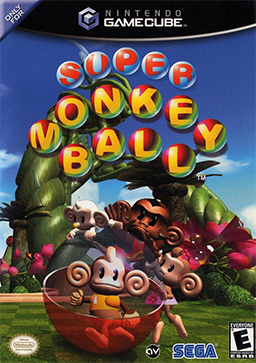
Super Monkey Ball is a 2001 platform party video game developed by Amusement Vision and published by Sega. The game debuted in Japan at the 2001 Amusement Operators Union trade show as Monkey Ball, an arcade cabinet running on Sega's NAOMI hardware and controlled with a distinctive banana-shaped analog stick. Due to the discontinuation of Sega's Dreamcast home console and the company's subsequent restructuring, an enhanced port dubbed Super Monkey Ball was released as a launch title for the GameCube in late 2001, garnering interest as Sega's first game published for a Nintendo home console.
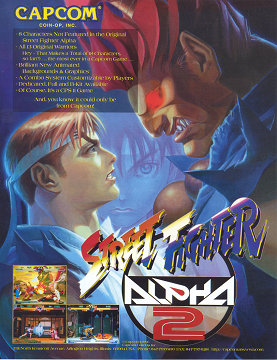
Street Fighter Alpha 2, known as Street Fighter Zero 2 in Japan, Asia, South America, and Oceania, is a 1996 fighting game originally released for the CPS II arcade hardware by Capcom. The game is a remake to the previous year's Street Fighter Alpha: Warriors' Dreams. The game features a number of improvements over the original, such as new attacks, stages, endings, and gameplay features. It was followed by Street Fighter Alpha 3.

Virtua Racing or V.R. for short, is a Formula One racing video game developed by Sega AM2 and released for arcades in 1992. Virtua Racing was initially a proof-of-concept application for exercising a new 3D graphics platform under development, the "Model 1". The results were so encouraging that Virtua Racing was fully developed into a standalone arcade title.

Super Monkey Ball 2 is a platform party video game developed by Amusement Vision and published by Sega in 2002 for the GameCube. It is the second installment in the Super Monkey Ball series, and the first installment to have a storyline and to be exclusively released on a home console.

Sega AM Research & Development No. 2, previously known as SEGA-AM2 Co., Ltd., is a video game development team within the Japanese multinational video game developer Sega. Yu Suzuki, who had previously developed arcade games for Sega including Hang-On and Out Run, was the first manager of the department.

Virtua Tennis 2, known as Tennis 2K2 in North America and Power Smash 2 in Japan, is a sequel to Virtua Tennis that was released for the Sega Dreamcast, Sega NAOMI arcade unit and Sony's PlayStation 2 in 2001–2002. New features included the ability to slice and play as female players such as Monica Seles, Serena Williams, Venus Williams and Lindsay Davenport and the males such as Patrick Rafter, Magnus Norman, Thomas Enqvist and Carlos Moyá and mixed doubles matches. The game was created and produced by Hitmaker, with Acclaim Entertainment publishing it in Europe for the PS2. This was the last Virtua Tennis game to be released for the Dreamcast following its discontinuation.

Virtua Striker is a series of association football sports video games released by Sega for arcades. Originally developed by Sega AM2 from 1994 to 1999, the series moved to Amusement Vision with Virtua Striker 3, but it later moved to Sega Sports Design R&D Dept. with Virtua Striker 4.

Virtua Fighter 2 is a 1994 fighting video game developed by Sega. It is the sequel to Virtua Fighter (1993), and the second game in the Virtua Fighter series. It was created by Sega's Yu Suzuki-headed AM2 and was released for arcades in 1994. Ports were released for the Sega Saturn in 1995 and Microsoft Windows in 1997.
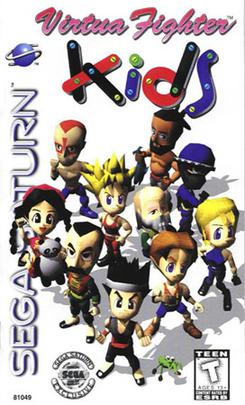
Virtua Fighter Kids is an installment in the Sega AM2 Virtua Fighter fighting game series. A super deformed version of Virtua Fighter 2, it was released in the arcade and on the Sega Saturn in 1996. Unlike Virtua Fighter 2, it was developed on the ST-V board.
Virtua Fighter is a series of fighting games created by Sega AM2 and designer Yu Suzuki. The original Virtua Fighter was released in December 1993 and has received four main sequels and several spin-offs. The highly influential first Virtua Fighter game is widely recognized as the first 3D fighting game released.

Ryu Ga Gotoku Studio is a video game developer housed within the Japanese video game company Sega as part of its Sega CS Research and Development No. 1 division. It is known for developing the games in the Like a Dragon series, which the studio is named after, since Yakuza 5.

















